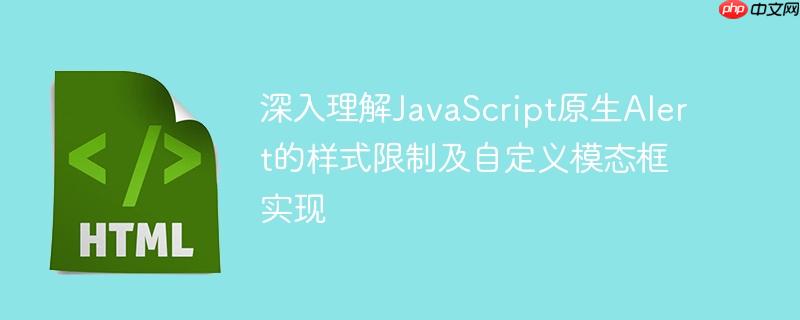
javascript中的alert()函数用于显示一个带有指定消息和确认按钮的警告框。然而,一个常见的误解是,开发者可以通过在alert()消息中嵌入html标签或css样式来改变其外观。例如,尝试将特定文本设置为粗体或红色:
alert("Hi how are you my <b> <span style='color: red;'> friend </span> </b>");这种方法在大多数现代浏览器(包括Microsoft Edge)中是无效的。原生alert弹窗的样式是由浏览器本身控制的,而非网页的CSS或JavaScript。这是出于以下几个主要原因:
因此,直接通过JavaScript代码或CSS样式来改变原生alert弹窗的字体、颜色、背景或其他任何视觉属性是不可能实现的。
既然原生alert无法定制,那么要实现带有自定义样式(如粗体、特定颜色)的弹窗效果,唯一的解决方案是创建自定义的模态对话框(Modal Dialog)或弹出窗口。这种方法允许开发者完全控制弹窗的HTML结构、CSS样式和JavaScript行为。
一个基本的自定义模态对话框通常包含以下几个部分:
立即学习“Java免费学习笔记(深入)”;
以下是一个简单的自定义模态对话框示例,演示如何实现带有粗体和红色文本的效果:
HTML 结构 (index.html):
<!DOCTYPE html>
<html lang="zh-CN">
<head>
<meta charset="UTF-8">
<meta name="viewport" content="width=device-width, initial-scale=1.0">
<title>自定义弹窗示例</title>
<link rel="stylesheet" href="style.css">
</head>
<body>
<button id="showAlertButton">显示自定义弹窗</button>
<div id="customModal" class="modal">
<div class="modal-content">
<span class="close-button">×</span>
<p id="modalMessage"></p>
</div>
</div>
<script src="script.js"></script>
</body>
</html>CSS 样式 (style.css):
/* 模态框背景遮罩 */
.modal {
display: none; /* 默认隐藏 */
position: fixed; /* 固定定位 */
z-index: 1000; /* 确保在最上层 */
left: 0;
top: 0;
width: 100%;
height: 100%;
overflow: auto; /* 允许滚动 */
background-color: rgba(0,0,0,0.4); /* 半透明黑色背景 */
justify-content: center; /* 水平居中 */
align-items: center; /* 垂直居中 */
}
/* 模态框内容区域 */
.modal-content {
background-color: #fefefe;
margin: auto; /* 自动边距实现居中 */
padding: 20px;
border: 1px solid #888;
width: 80%; /* 宽度 */
max-width: 500px; /* 最大宽度 */
border-radius: 8px;
box-shadow: 0 4px 8px 0 rgba(0,0,0,0.2), 0 6px 20px 0 rgba(0,0,0,0.19);
position: relative; /* 用于定位关闭按钮 */
}
/* 关闭按钮 */
.close-button {
color: #aaa;
float: right; /* 浮动到右侧 */
font-size: 28px;
font-weight: bold;
cursor: pointer;
position: absolute;
top: 10px;
right: 20px;
}
.close-button:hover,
.close-button:focus {
color: black;
text-decoration: none;
cursor: pointer;
}
/* 自定义文本样式 */
.highlight-bold {
font-weight: bold;
}
.highlight-red {
color: red;
}JavaScript 逻辑 (script.js):
document.addEventListener('DOMContentLoaded', function() {
const modal = document.getElementById('customModal');
const messageParagraph = document.getElementById('modalMessage');
const closeButton = document.querySelector('.close-button');
const showAlertButton = document.getElementById('showAlertButton');
// 显示模态框的函数
function showCustomAlert(messageHtml) {
messageParagraph.innerHTML = messageHtml; // 支持HTML内容
modal.style.display = 'flex'; // 使用flexbox实现居中
}
// 隐藏模态框的函数
function hideCustomAlert() {
modal.style.display = 'none';
}
// 点击按钮显示自定义弹窗
showAlertButton.onclick = function() {
const fullMessage = "Hi how are you my <span class='highlight-bold highlight-red'>friend</span>";
showCustomAlert(fullMessage);
};
// 点击关闭按钮隐藏模态框
closeButton.onclick = function() {
hideCustomAlert();
};
// 点击模态框外部区域隐藏模态框
window.onclick = function(event) {
if (event.target == modal) {
hideCustomAlert();
}
};
});在这个示例中,我们通过JavaScript动态设置modalMessage的innerHTML,从而允许我们插入带有<span>标签和自定义CSS类的HTML内容,实现了对特定文本的粗体和红色样式控制。
采用自定义模态框方案,除了解决原生alert的样式限制外,还带来诸多优势:
在实现自定义模态对话框时,需要考虑以下几点:
尽管JavaScript的原生alert函数因其简单和即时性而常用,但其在样式定制方面的局限性是显而易见的。对于需要自定义外观、内容或交互的提示信息,创建自定义的模态对话框是唯一且推荐的解决方案。通过结合HTML、CSS和JavaScript,开发者可以构建功能强大、视觉美观且用户体验更佳的弹窗,从而满足现代Web应用的需求。
以上就是深入理解JavaScript原生Alert的样式限制及自定义模态框实现的详细内容,更多请关注php中文网其它相关文章!

每个人都需要一台速度更快、更稳定的 PC。随着时间的推移,垃圾文件、旧注册表数据和不必要的后台进程会占用资源并降低性能。幸运的是,许多工具可以让 Windows 保持平稳运行。

Copyright 2014-2025 https://www.php.cn/ All Rights Reserved | php.cn | 湘ICP备2023035733号